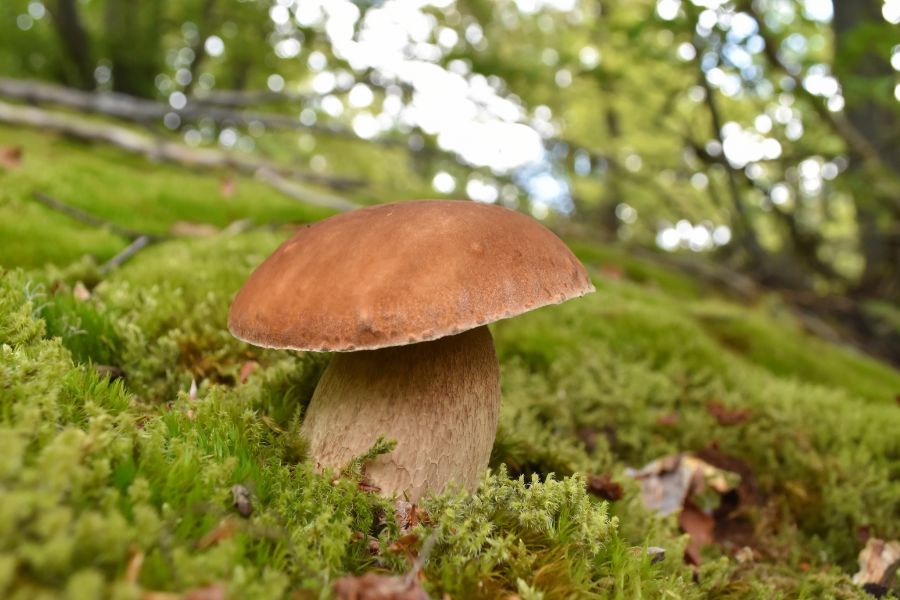Porcini mushroom season in California draws serious foragers each year hoping to score one of the most flavorful wild edibles around. Known for their deep nutty flavor and meaty texture, porcini are highly valued in both culinary and commercial markets.
These mushrooms are firm yet tender when cooked, making them a standout in risottos, soups, and slow braises. Even a small harvest can transform a simple meal into something rich and savory.
When dried, porcini take on an even more concentrated flavor, and the soaking liquid becomes a broth full of earthy depth. Top-grade dried porcini can easily fetch over $60 per pound!
Fresh porcini often sell for $30 to $60 per pound in the U.S., with prices spiking in top culinary cities or during short harvest windows. Knowing the right places to search can help you head home with a valuable and flavorful porcini harvest.
If you want to pair your mushroom hunt with a chance to spot some remarkable rocks and minerals, a single tool can make that easy. Rock Chasing’s California Rocks & Minerals Identification Field Guide gives you the confidence to recognize what you pick up, so you never walk past something special without realizing it.
What We Cover In This Article:
- What different types of Porcini mushrooms look like
- The mushrooms that look like Porcini you should avoid
- Our best tips for finding Porcini mushrooms
- The top places in the state to find porcini
- The best times of year to look for them
- The extensive local experience and understanding of our team
- Input from multiple local foragers and foraging groups
- The accessibility of the various locations
- Safety and potential hazards when collecting
- Private and public locations
- A desire to include locations for both experienced foragers and those who are just starting out
Using these weights we think we’ve put together the best list out there for just about any forager to be successful!
A Quick Reminder
Before we get into the specifics about where and how to find these plants and mushrooms, we want to be clear that before ingesting any wild plant or mushroom, it should be identified with 100% certainty as edible by someone qualified and experienced in mushroom and plant identification, such as a professional mycologist or an expert forager. Misidentification can lead to serious illness or death.
All plants and mushrooms have the potential to cause severe adverse reactions in certain individuals, even death. If you are consuming wild foragables, it is crucial to cook them thoroughly and properly and only eat a small portion to test for personal tolerance. Some people may have allergies or sensitivities to specific mushrooms and plants, even if they are considered safe for others.
The information provided in this article is for general informational and educational purposes only. Foraging involves inherent risks.
What Porcini Mushrooms Look Like
Porcini technically refers to one mushroom species: Boletus edulis, also known as the king bolete. But in many parts of the U.S., several other edible mushrooms in the same genus or family are also called porcini. These close relatives belong to the broader Boletus group and share a similar look, taste, and texture:
Porcini (Boletus edulis)

Porcini, also known as king bolete, cèpe, or penny bun, is a large, thick-stemmed mushroom with a smooth brown cap and a sponge-like underside instead of gills. Its firm white flesh has a nutty, earthy flavor that holds up well in cooking and drying. This species is the classic or “true” porcini.
It’s most commonly found in the Pacific Northwest, especially in coastal forests of Oregon, Washington, and Northern California. It grows in coniferous woods, often near spruce, fir, or pine, and usually appear in the fall after consistent rainfall.
Most people don’t realize how many incredible rocks California hides in its mountains, deserts, and beaches. This guide shows exactly what you’ve been walking past.
🌈 300+ color photos of real California specimens
🪨 Raw + polished examples make identification simple
🏜️ Covers coastlines, gold country, Sierras & more
💦 Waterproof pages built for real outdoor use
California King Bolete (Boletus edulis var. grandedulis)
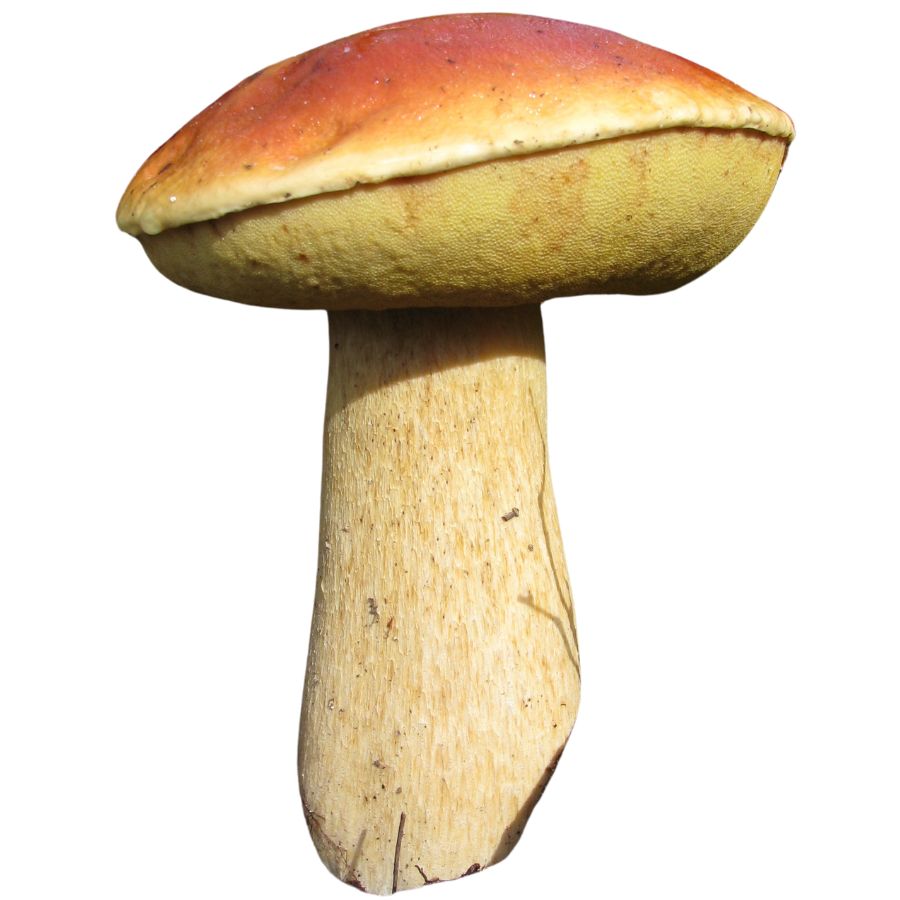
The California king bolete, sometimes called the Sierra porcini or just king bolete, is a large, stocky mushroom with a smooth brown cap and a thick white stem. It has a firm texture and a deep, nutty flavor that holds up well in cooking.
This porcini variety grows in the Sierra Nevada and coastal forests of California, especially from fall through early winter. It prefers mixed woodlands with fir, pine, or tanoak and often appears after the first heavy rains of the season.
Spring King Bolete (Boletus rex-veris)
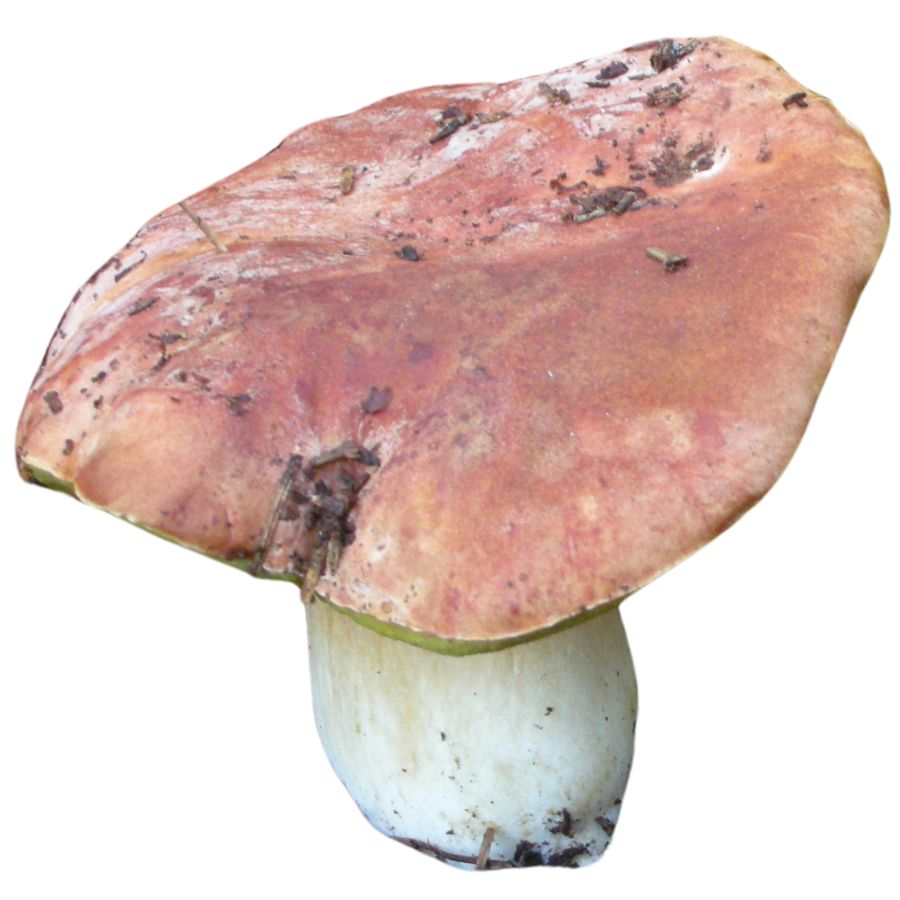
The spring king bolete, often called the spring porcini, has a pale brown cap, a stout white stem, and a firm texture that stays intact during cooking. Its flavor is rich and earthy, with a slightly sweet finish that sets it apart from other boletes.
You’ll find this mushroom in the western mountains of the United States, especially in California, Oregon, and parts of the Rocky Mountains. It appears in high-elevation conifer forests in late spring and early summer, usually near snowmelt.
White King Bolete (Boletus barrowsii)
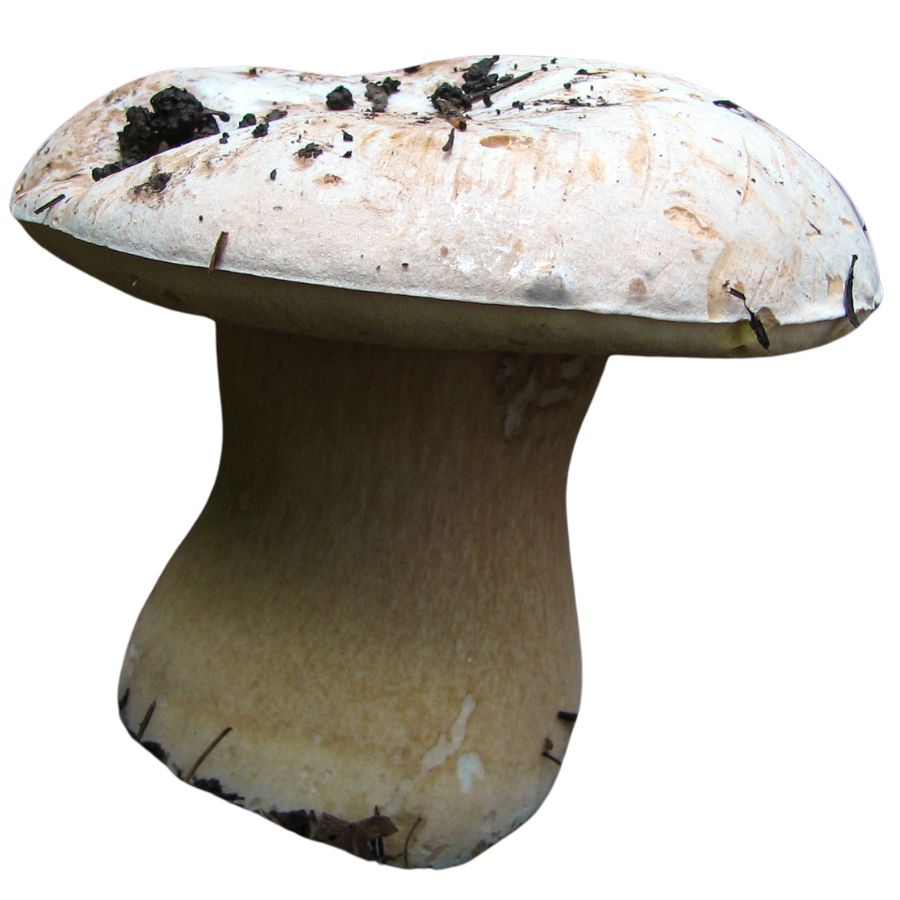
The white king bolete, sometimes called Barrows’ bolete or desert porcini, is a pale, chunky mushroom with a white to ivory cap and a thick stem. It has a smooth, mild flavor that deepens when cooked and is especially prized when young and firm.
It grows in the southwestern United States, especially in Arizona and New Mexico, and is often found in ponderosa pine forests. Unlike other porcini, it tends to fruit during the summer monsoon season after warm rains.
Almost Bluing King Bolete (Boletus subcaerulescens)
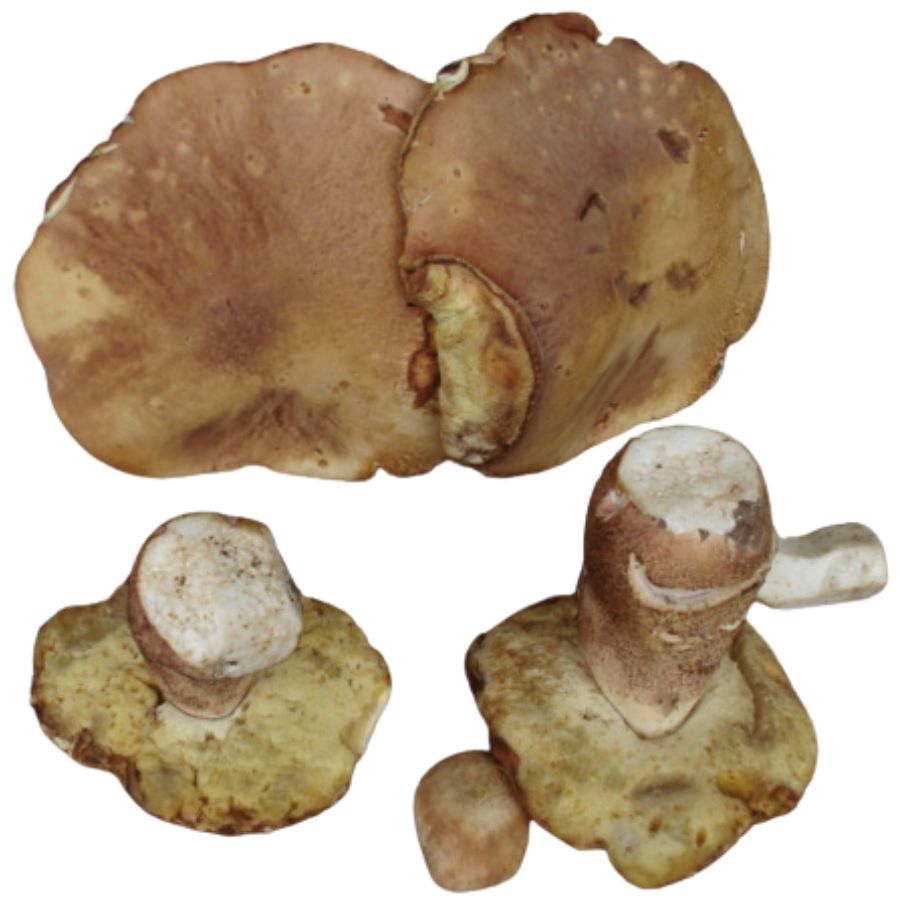
The almost bluing king bolete, also known as the blue-staining porcini, has a light brown cap and a stout stem covered in a fine network of raised lines. It gets its name from the faint blue tint that sometimes shows near the base when cut, though the color change is subtle and doesn’t always appear.
This porcini is edible and well-regarded for its firm texture and mild, nutty flavor. It cooks up nicely in sautés or soups and holds its shape without turning mushy.
It grows around the Great Lakes and into the Northeast, favoring mixed forests with spruce, fir, or pine and usually shows up in late summer after steady rain.
Fib King (Boletus fibrillosus)
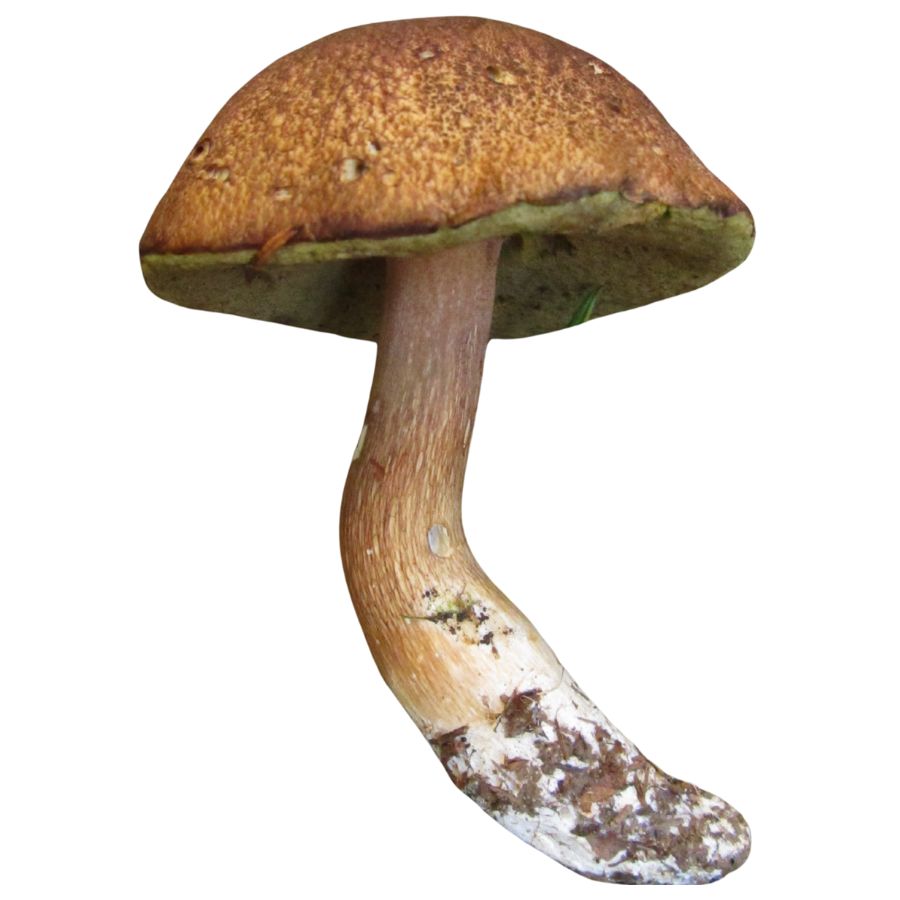
The fib king, sometimes called the fuzzy porcini, has a dark reddish-brown cap with a matte, finely fibrous surface and a thick pale stem. Its dense flesh has a mild, pleasant flavor that deepens when cooked, making it a solid addition to savory dishes.
You can find this mushroom is found in the Pacific Northwest, especially in the coastal forests of Oregon and Washington. It prefers old-growth conifer forests and usually fruits in the fall after sustained rain.
Mushrooms That Look Like Porcini But Aren’t
In this state, a handful of mushrooms resemble porcini at first glance. Knowing the differences can help you avoid a bad meal or worse:
Satan’s Bolete (Boletus satanas)
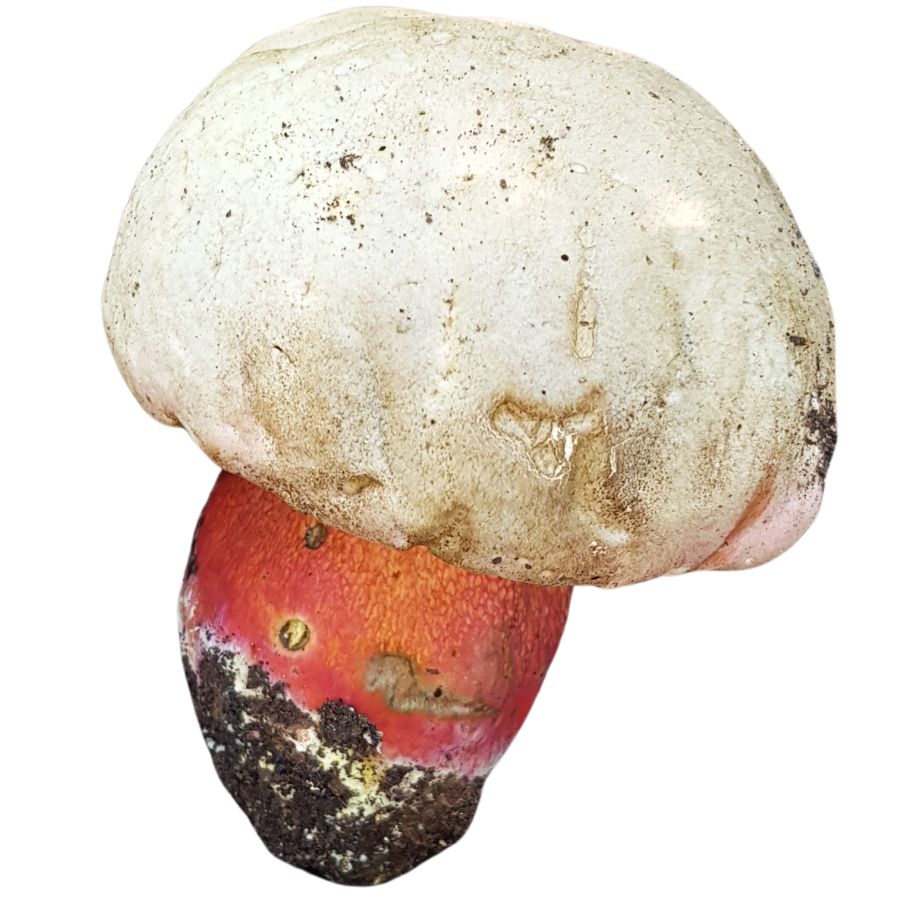
Satan’s bolete is a large, thick mushroom with a pale, almost white cap and a bright red stem. The pores underneath are yellow but bruise blue when handled, making it stand out from other boletes in the woods.
It grows in warmer parts of the southeastern U.S., especially in hardwood forests with oak or beech. This mushroom is toxic and should never be eaten as it can cause severe gastrointestinal distress including vomiting and diarrhea.
Sensitive Bolete (Boletus sensibilis)
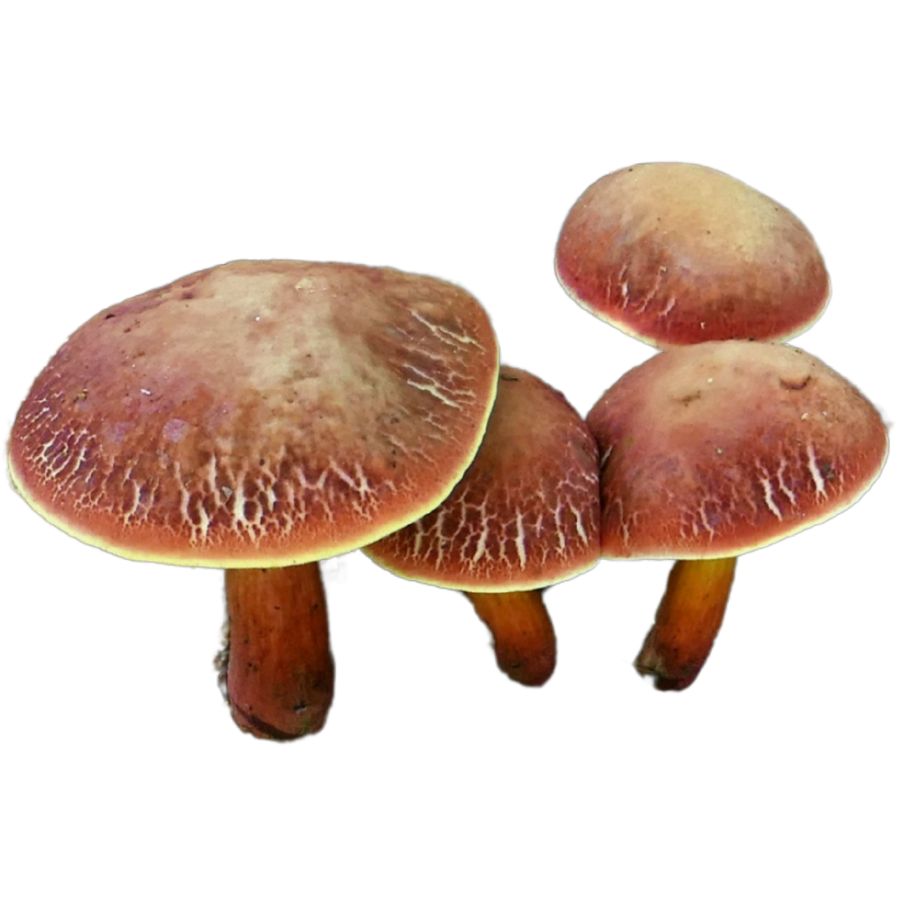
Sensitive bolete, sometimes called the “bruise bolete,” is known for how quickly it turns blue when touched or cut. It has a smooth yellow cap, red or pinkish pores, and a yellow stem that often shows bruising almost instantly.
You can find it across the eastern and southeastern U.S., especially in mixed hardwood forests during summer. While it might look appealing, this mushroom is considered toxic and can cause stomach cramps, nausea, and vomiting if eaten. Even small amounts may lead to unpleasant symptoms, so it’s best left alone.
Huron Bolete (Boletus huronensis)
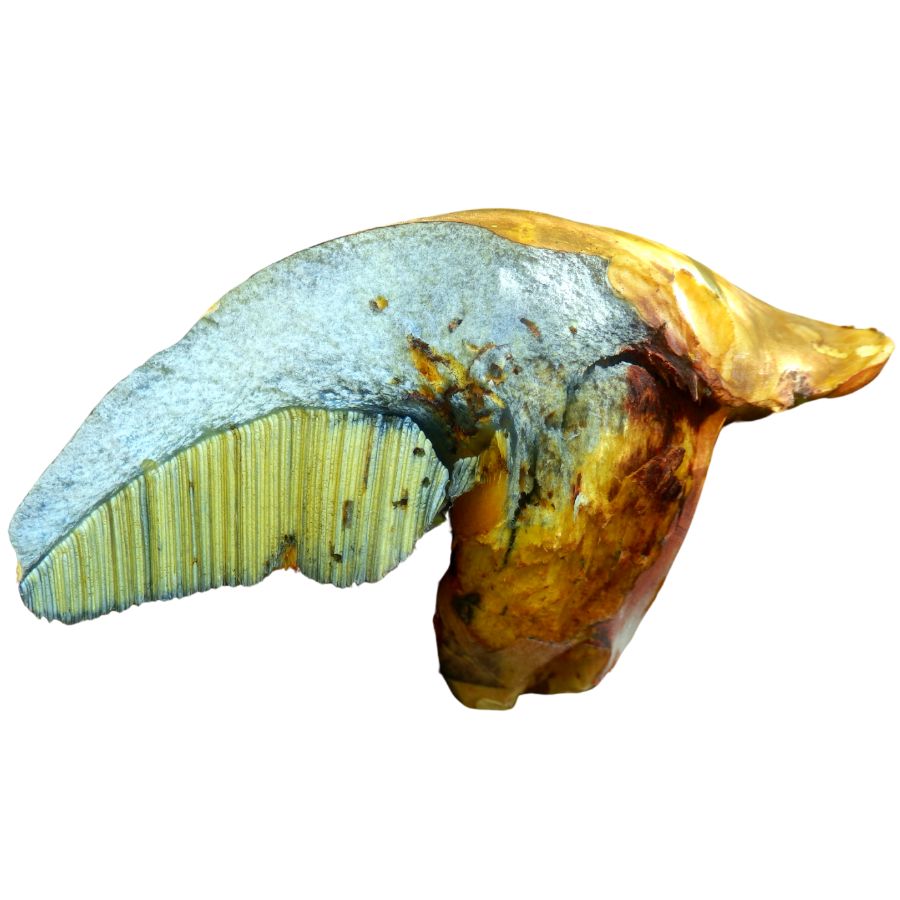
Huron bolete is a chunky mushroom with a dull brown cap, yellow pores, and a thick, slightly reddish stem that bruises blue when handled. It may not look as bold as other toxic boletes, but it’s still one to avoid.
Sometimes called the “Great Lakes bolete,” this species is found in the Great Lakes region, especially in Michigan and nearby states, growing under hardwoods like oak and beech. It’s considered poisonous and can cause intense nausea, cramps, and vomiting. While not deadly, the symptoms can be severe enough to require medical attention.
Bitter Bolete (Tylopilus felleus)
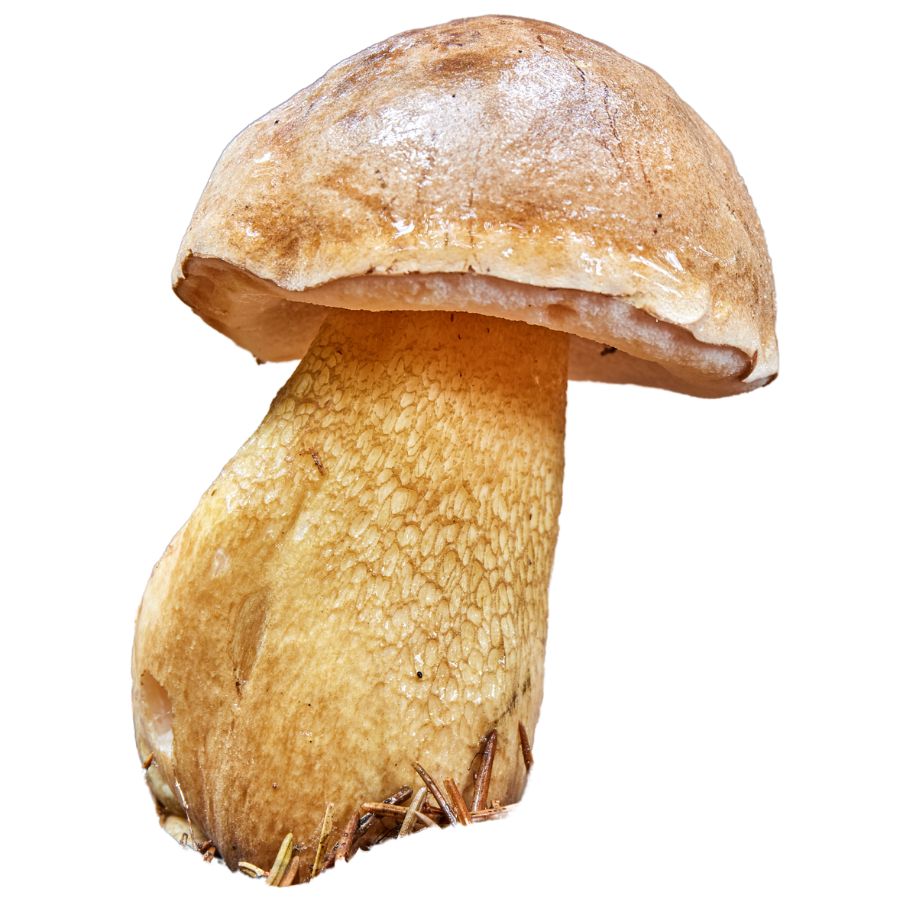
Bitter bolete, also called the “bitter tasting bolete,” looks a lot like an edible porcini at first glance. It has a brown cap, pinkish pores, and a thick, netted stem that can fool even experienced foragers.
This mushroom grows widely across the country, especially in eastern forests with oak or pine. It isn’t toxic, but the taste is so bitter that even a small piece can ruin a whole dish. Most people spit it out right away, but if swallowed, it can still lead to mild stomach upset.
Two-colored Bolete (Baorangia bicolor)
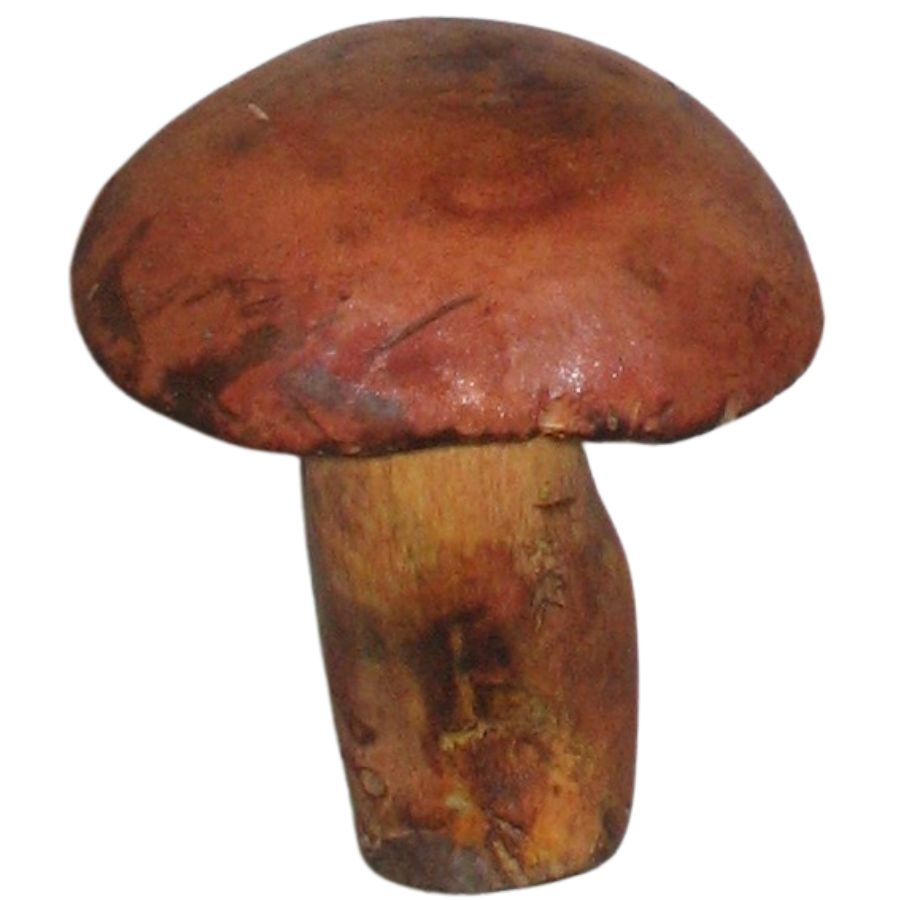
Two-colored bolete, sometimes called the “bicolor bolete,” has a bright yellow stem and cap with deep red tones near the base and edge. The pores are yellow and stain blue when touched, giving it a bold and colorful look.
It’s found across the eastern U.S., especially in oak and mixed hardwood forests during summer and fall. This species is edible and often enjoyed for its mild flavor and tender texture when cooked. Some people report digestive discomfort, so it’s best to test small amounts first.
How to Find Porcini Mushrooms
Porcini mushrooms don’t show up just anywhere. They grow in very specific places, and understanding the right mix of trees, soil, and seasonal conditions is the key to finding them.
Focus on Mixed Forests with Both Hardwoods and Conifers
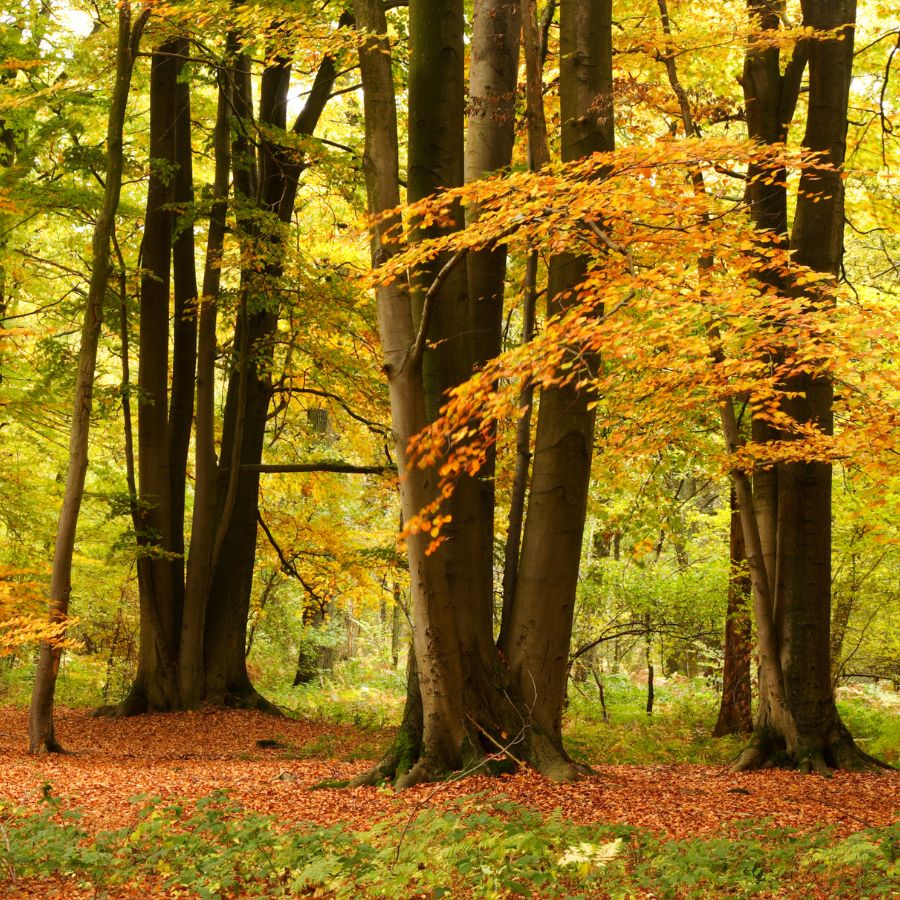
Mixed hardwood and conifer forests are common habitats for porcini mushrooms. In the Northeast, mature oak-maple forests with scattered hemlocks are good spots. In the Rockies and the Pacific Northwest, they thrive in higher-elevation forests dominated by spruce and fir.
Old-growth or long-established forests are usually more productive than young stands.
Wait Several Days After a Steady Rainfall
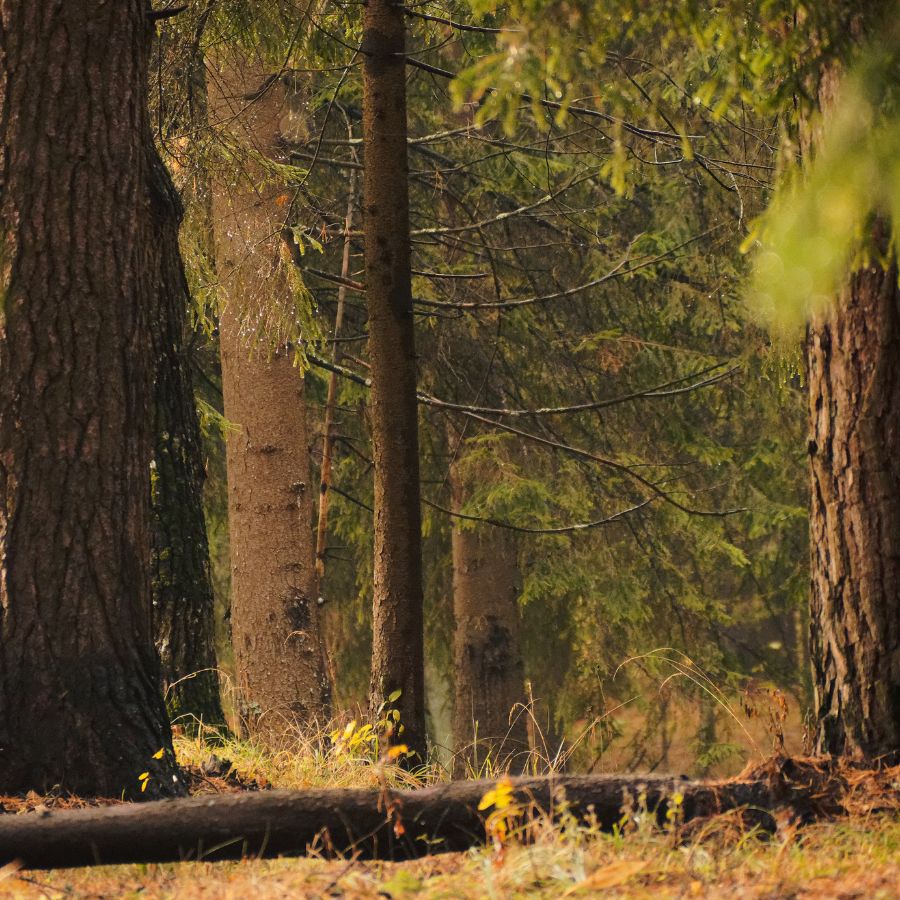
Consistent moisture is key. These mushrooms tend to appear several days after steady rain, especially if followed by warm temperatures.
They rarely grow during droughts or in overly wet, swampy areas. A moist but not soggy forest floor is ideal.
Search in Loose, Acidic Soil with Plenty of Leaf Litter
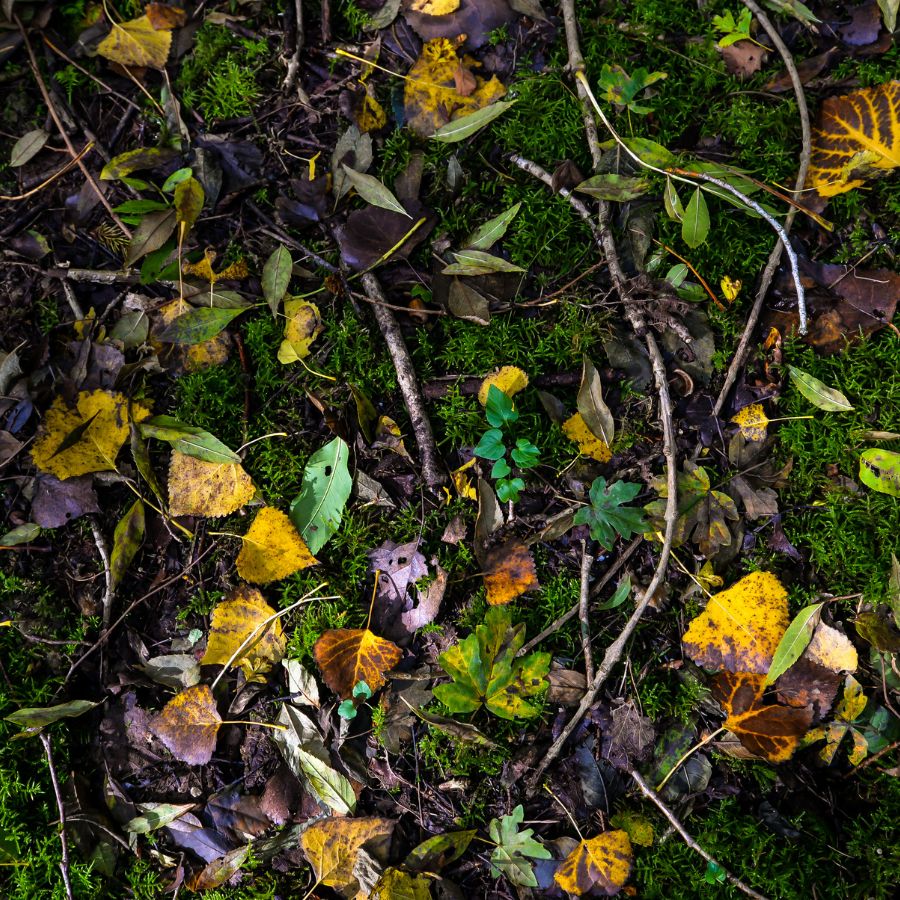
Porcini and their close relatives grow best in well-drained soils that are slightly acidic. Sandy loam or loose forest soil rich in organic material tends to support healthy mushroom growth.
They are rarely found in compacted or heavily clay-based ground. Look for them where the topsoil is crumbly and full of leaf litter.
Check Near Animal Paths, Broken Branches, and Debris Piles
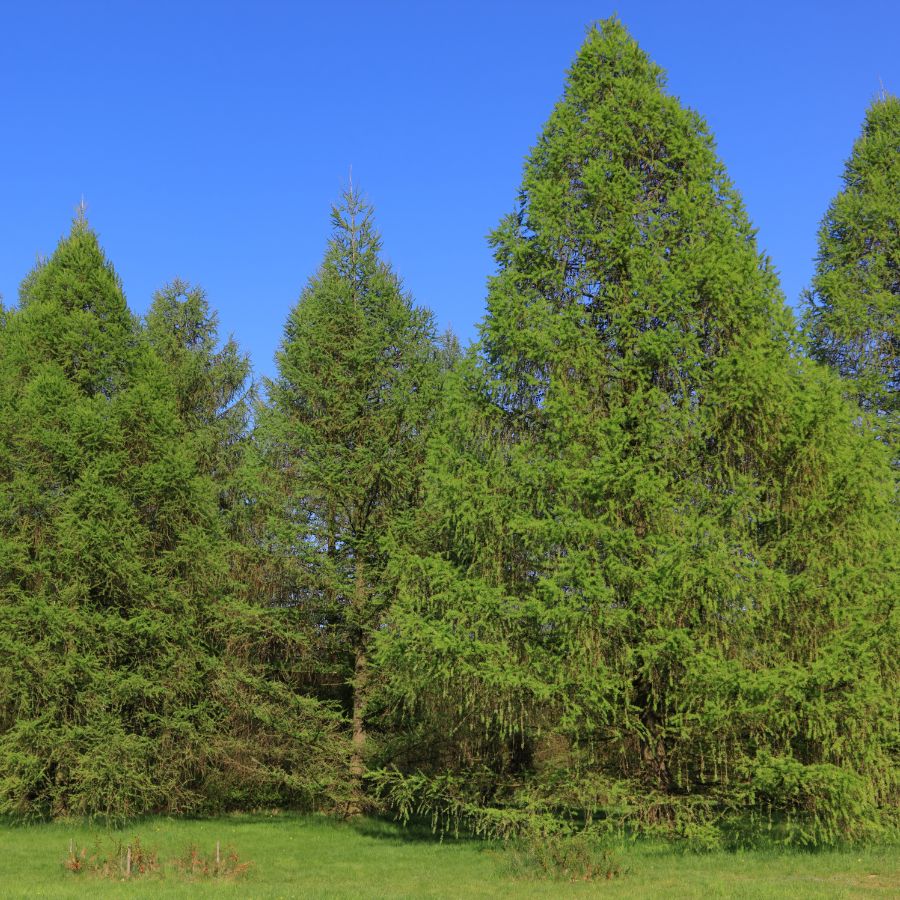
Porcini and edible boletes often grow near the edges of clearings, trails, or small breaks in the canopy. These spots get dappled light, which helps warm the soil while keeping it moist.
Look along well-used animal paths or areas with broken branches and scattered debris. These partial openings tend to support just the right conditions for a flush.
Follow Animal Dig Marks and Shifts in the Forest Floor
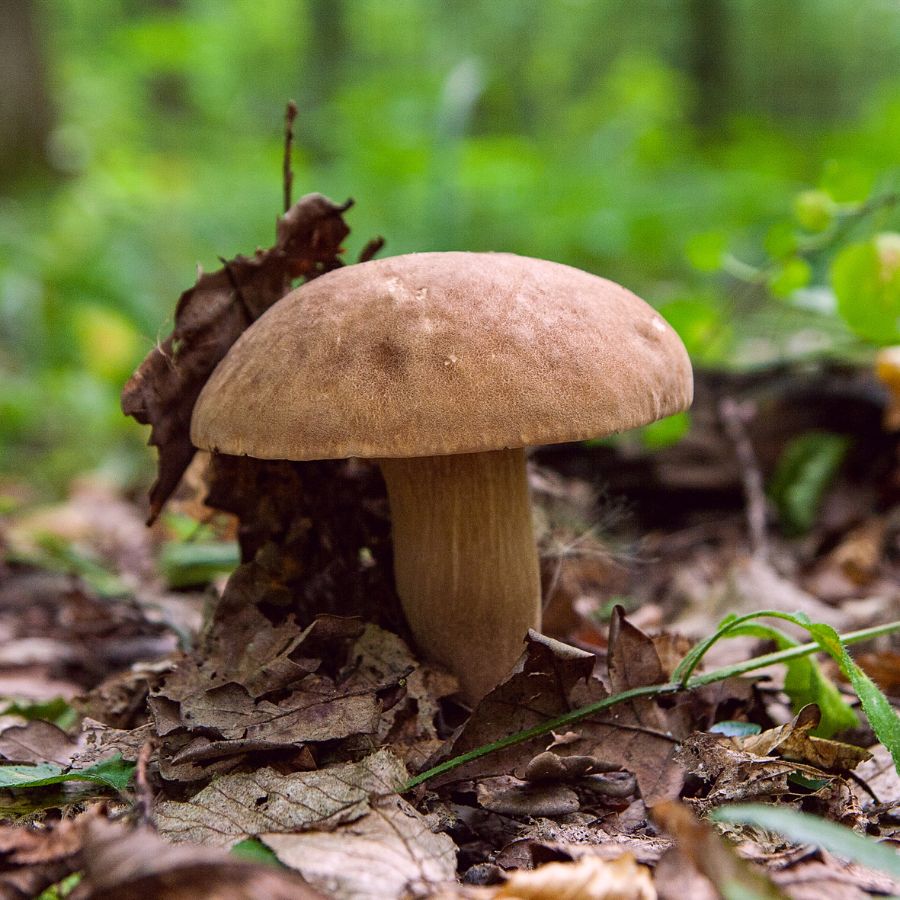
On the forest floor, mossy patches are good indicators for mushrooms. Porcini may push up under duff, creating small mounds or cracks in the soil. Displaced needles, uneven ground, or fresh animal dig marks can sometimes point to hidden mushrooms nearby.
Pay attention to slight changes in texture or elevation underfoot.
Focus on North-Facing Mountain Slopes
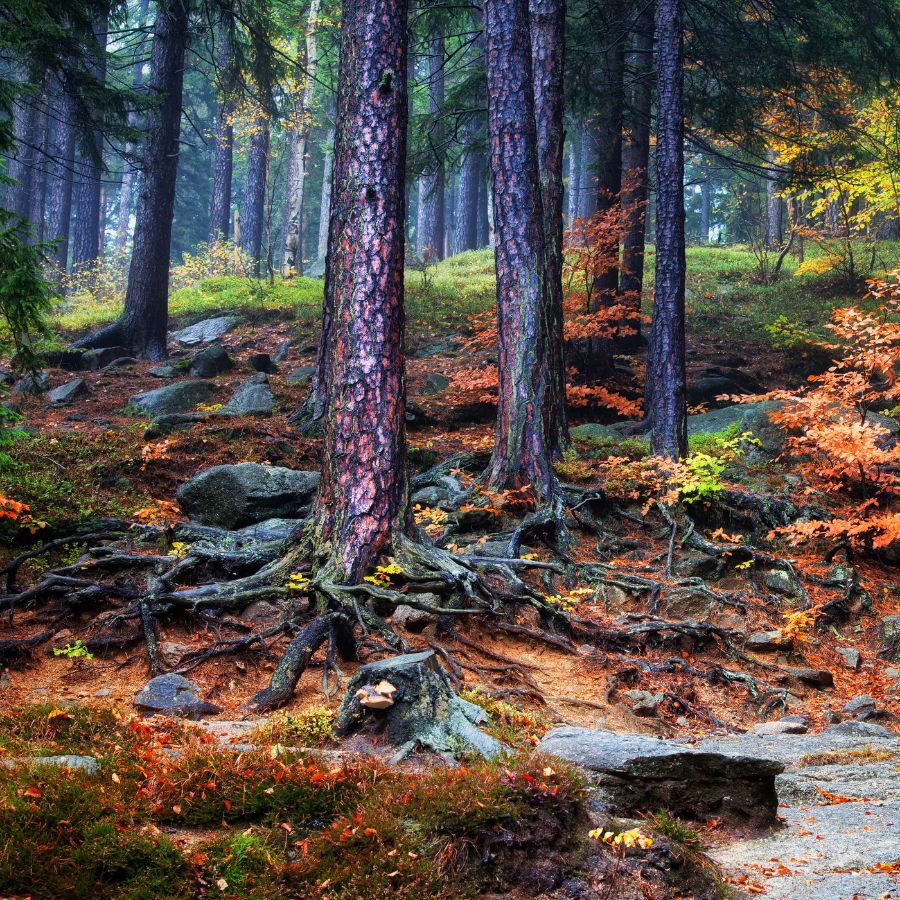
In mountain regions, porcini and edible boletes tend to appear between 5,000 and 9,000 feet. They favor gentle slopes with good water runoff but not erosion.
South-facing slopes may dry too quickly, while north-facing ones hold moisture longer. Sloped terrain with a soft duff layer is often productive after summer rains.
Before you head out
Before embarking on any foraging activities, it is essential to understand and follow local laws and guidelines. Always confirm that you have permission to access any land and obtain permission from landowners if you are foraging on private property. Trespassing or foraging without permission is illegal and disrespectful.
For public lands, familiarize yourself with the foraging regulations, as some areas may restrict or prohibit the collection of mushrooms or other wild foods. These regulations and laws are frequently changing so always verify them before heading out to hunt. What we have listed below may be out of date and inaccurate as a result.
Where You Can Find Porcini
Porcini mushrooms tend to grow in specific forests across the state, often tied to elevation, soil type, and tree cover. Knowing where to look can make all the difference in finding them during their short fruiting season.
Shasta-Trinity National Forest
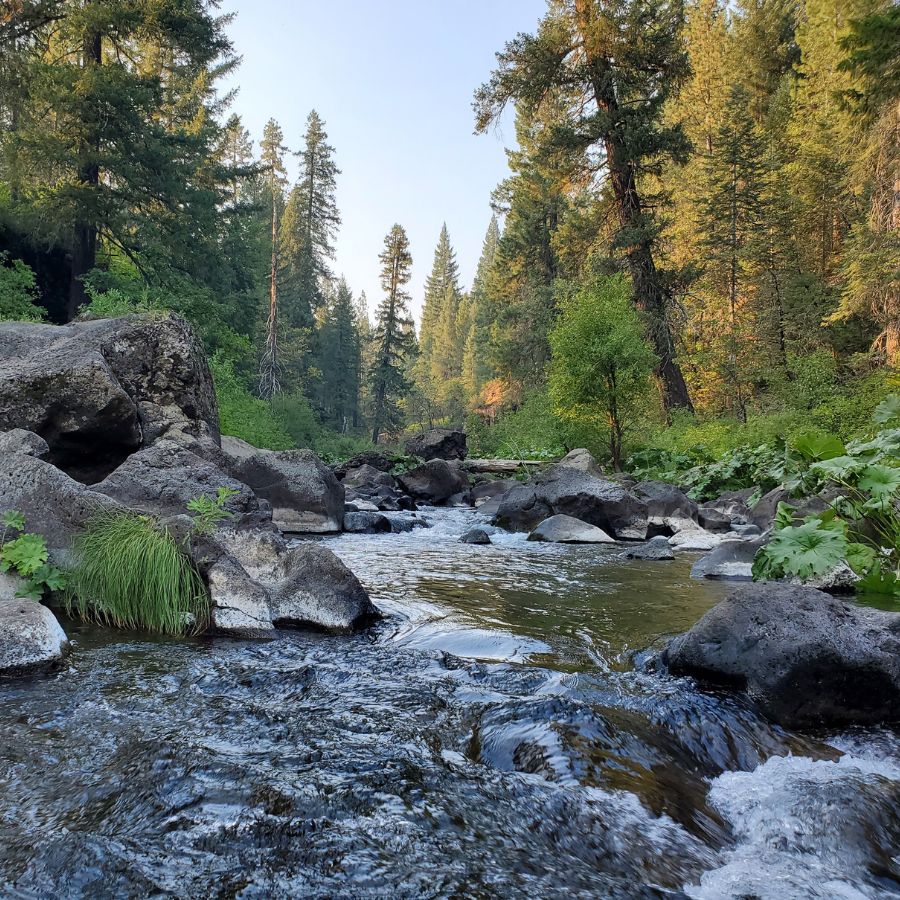
Shasta-Trinity National Forest is home to California’s tallest volcano, Mount Shasta, whose snowmelt feeds dozens of creeks and springs throughout the region. Along the forest’s higher-elevation trails, you’ll find thick stands of conifers, deep duff, and the kind of moist, shaded ground where porcini mushrooms tend to grow.
The forest around Castle Lake has a dense canopy of fir and pine, with plenty of decaying wood and moss-covered soil. If you’re heading along the trail toward Heart Lake, keep an eye out as the path skirts through mixed forest zones where porcini are often found pushing through the needle litter.
Trinity Alps Wilderness sees cooler temperatures and consistent rainfall at elevations between 4,000 and 6,000 feet, creating the right conditions for porcini during a good season.
Areas around Swift Creek and Granite Lake have old-growth conifers and moist hillsides that make them solid bets when the timing and weather align.
The trail network near Deadfall Lakes, just west of Mount Eddy, cuts through a rich mix of red fir and hemlock—both excellent host trees for porcini.
If your kids constantly ask “What’s this rock?”, this guide finally gives you an answer you don’t have to Google later. Quick photos, simple descriptions, and rugged pages make ID’ing rocks fun instead of frustrating.
🔍 Fast visual matching—no geology background needed
💦 Wipe-clean pages made for creeks, beaches & dirt
📚 Simple explanations for beginners of all ages
🌄 Great for California hikes, creek beds & camping trips
Klamath National Forest
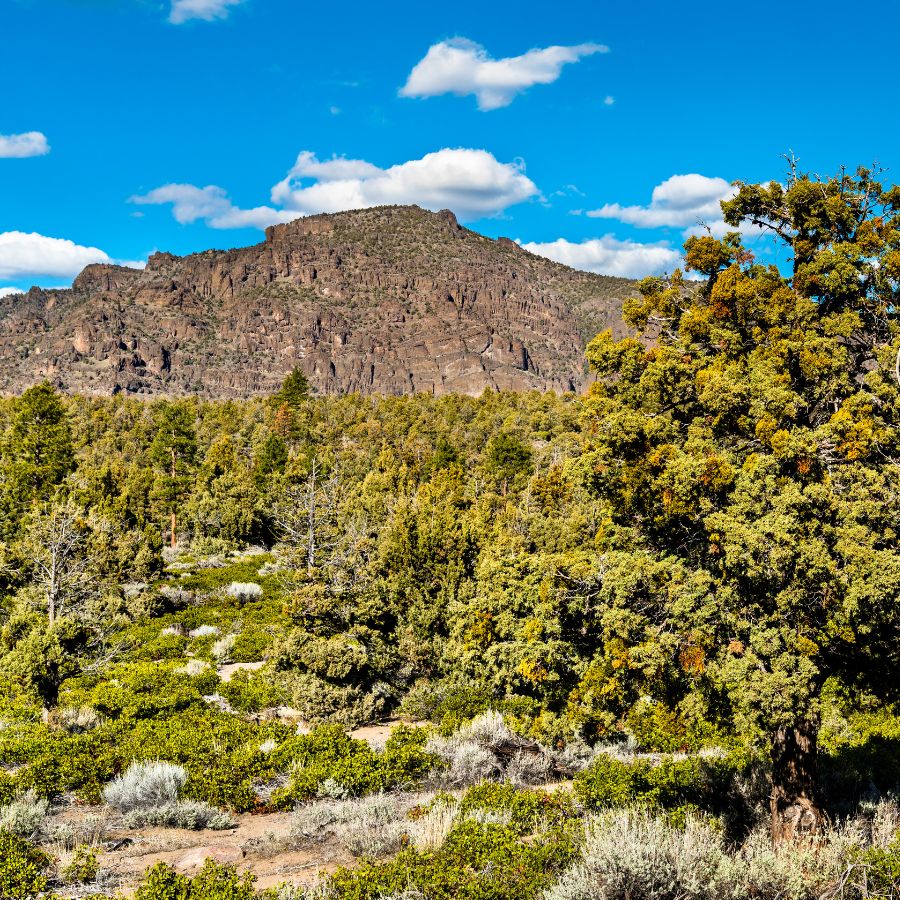
Klamath National Forest spans a rugged swath of Northern California and is home to some of the most geologically complex terrain in the Pacific Northwest. Within that varied topography, the dense conifer stands and seasonal moisture patterns in the forest create conditions where porcini mushrooms are often found.
Along the Pacific Crest Trail as it passes through the Marble Mountains, you’ll encounter mature fir and pine forests where porcini are known to fruit. Sections between Sky High Lakes and Marble Valley hold just the right mix of duff-covered soil and canopy cover to support their growth after fall rains.
Farther west, the area around Elk Creek and its tributaries near Happy Camp provides another stretch of porcini-friendly ground. The mixed woodland above the creek stays humid longer into the season, and the scattered tanoak and Douglas fir in this zone give porcini plenty of room to thrive.
Up near the northern boundary, the terrain around Seiad Valley and the surrounding Siskiyou Mountains features older forest and little disturbance—both favorable for porcini.
Trails like the one leading up to Cook and Green Pass wind through higher elevation zones where thick mats of needles and moss blanket the forest floor, setting the stage for a fruitful hunt.
Six Rivers National Forest
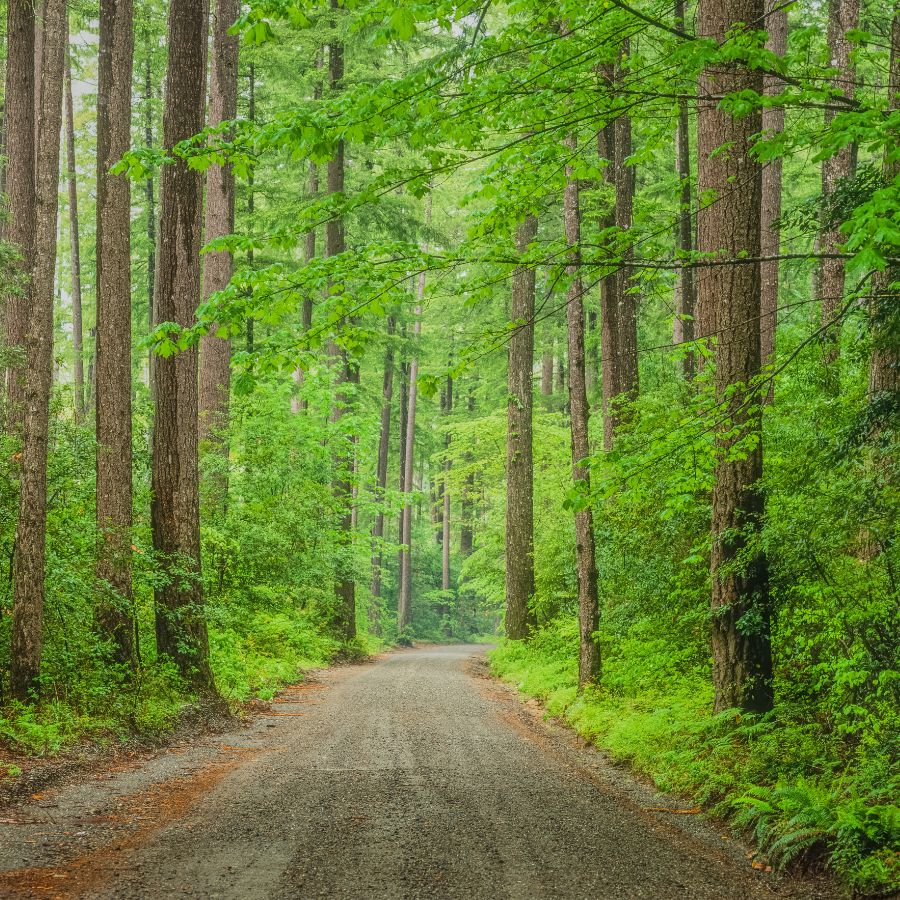
Six Rivers National Forest is named for the Smith, Klamath, Trinity, Mad, Van Duzen, and Eel Rivers that run through its rugged terrain. Within this diverse expanse of redwood groves, Douglas-fir stands, and coastal mountains, porcini mushrooms have room to thrive in the cool, damp soil beneath coniferous canopies.
Up near the South Fork of the Trinity River, the Horse Ridge area provides a high-elevation mix of fir and pine that holds moisture well into late fall. The shaded slopes off Forest Road 1S14 offer just the kind of decomposing duff and cover where porcini are known to appear.
Further north, the area surrounding Bear Basin Butte in the Gasquet Ranger District is worth noting. The ridges and flats near the Butte’s summit host mature fir and hemlock stands where porcini can grow after fall rains, especially near the intersecting spurs of Bear Basin Lookout Road.
Closer to the coast, the region around Mill Creek Watershed near Hiouchi maintains a fog-fed moisture level that’s ideal for many fall mushrooms. In the forested drainages along East Fork Mill Creek, porcini have been spotted in the duff beneath tanoak and Sitka spruce.
Tahoe National Forest
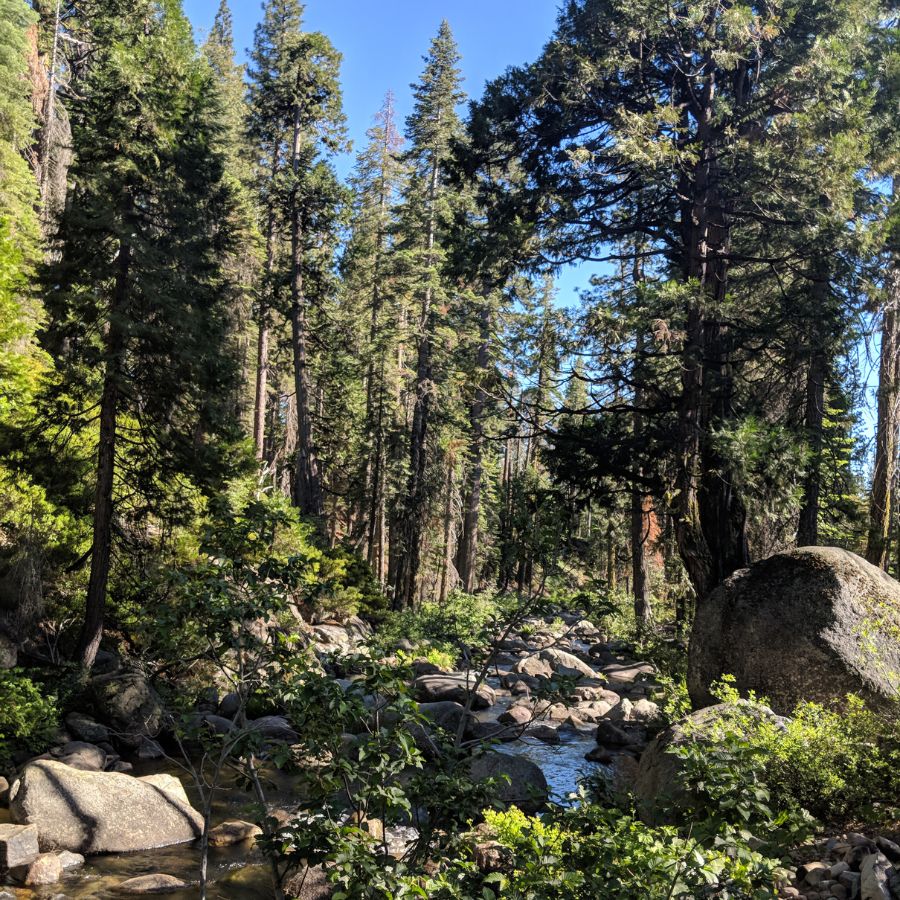
Tahoe National Forest spans over 800,000 acres and includes parts of both the Sierra Crest and the northern end of the Lake Tahoe Basin. Along its higher ridges and deeply wooded slopes, you’ll find a mix of elevation, tree cover, and soil conditions that are well-suited to porcini mushrooms.
North of Truckee, the forest around Sagehen Creek offers a mix of mature conifers and consistent ground moisture, especially near the Sagehen Creek Trail. This area’s shaded understory and elevation range make it one of the better places in the forest where porcini are likely to fruit during the right season.
Further west, the Bowman Lake area sits within a densely wooded basin surrounded by granite ridges and lodgepole pine. When late-summer rains hit, the forest floor around Grouse Ridge and Sawmill Lake becomes especially promising for spotting porcini in the leaf litter and duff.
South of Yuba Pass, along the Pacific Crest Trail near Sierra Buttes, the forest transitions into high-elevation fir and hemlock stands with deep soil and plenty of decaying organic matter. Porcini have been known to emerge in these stretches, especially near Tamarack Lakes and along forested slopes.
Eldorado National Forest
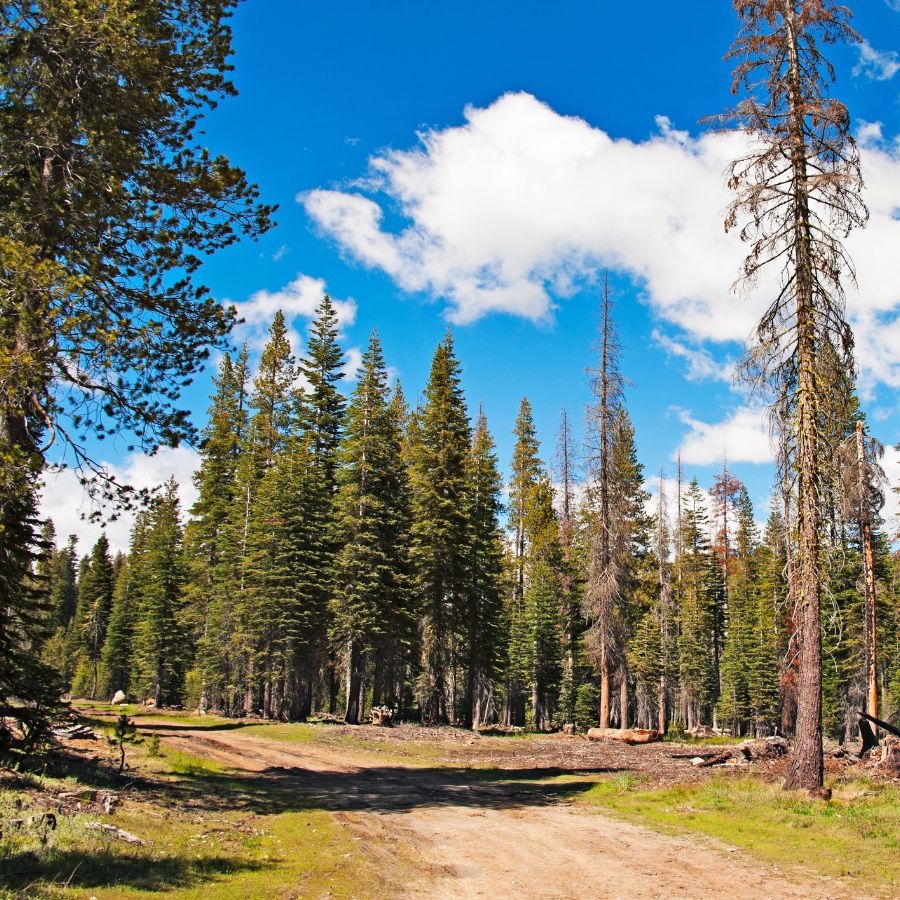
Eldorado National Forest stretches across the western slopes of the Sierra Nevada and includes everything from granite basins to thick conifer woodlands. That kind of elevation range and forest composition creates several pockets where porcini mushrooms tend to fruit reliably after late-season rains.
Near Ice House Reservoir, the surrounding slopes are dotted with red fir and mixed conifers. Porcini often appear in these areas when conditions line up, especially along the shaded segments of Ice House Road and the turnoffs that lead toward Union Valley Reservoir.
The area around Wrights Lake also supports porcini growth, thanks to its high elevation, damp meadows, and the dense stands of fir and lodgepole pine nearby. Trails like Twin Lakes and Lyons Creek Trail pass through terrain that gets just enough sun to warm the soil without drying it out too fast.
South of Highway 88, the terrain near Caples Creek and Schneider Camp hosts stretches of mature forest with thick duff layers. The shady drainages along the Caples Creek Trail hold enough elevation and organic debris to support patches when the monsoon moisture moves in.
Additional Locations to Find Porcini
There are several reliable locations across the state where porcini mushrooms grow:
| Central Coast | Porcini Collection Details |
| Big Basin Redwoods State Park | Regulated foraging in certain areas |
| Henry Cowell Redwoods State Park | Foraging for personal use only |
| Los Padres National Forest | Limited foraging allowed with restrictions |
| Pfeiffer Big Sur State Park | Personal use only, regulated species |
| North Coast | Porcini Collection Details |
| Humboldt Redwoods State Park | Non-invasive foraging for personal use only |
| Mendocino National Forest | No commercial foraging allowed |
| Mount Tamalpais State Park | Native plant foraging is restricted |
| Redwood National and State Parks | Foraging generally not allowed |
| Samuel P. Taylor State Park | Limited seasonal foraging allowed |
| Six Rivers National Forest | Permit required for mushroom foraging |
| Northeastern CA | Porcini Collection Details |
| Modoc National Forest | Foraging permitted in most public zones |
| Northern CA | Porcini Collection Details |
| Klamath National Forest | Some areas require permits |
| Lassen National Forest | Limited foraging; check species guidelines |
| Shasta-Trinity National Forest | Personal use foraging encouraged |
| Northern Sierra | Porcini Collection Details |
| Plumas National Forest | Foraging for non-commercial use only |
| Sierra Nevada | Porcini Collection Details |
| Eldorado National Forest | Foraging for personal use only |
| Sierra National Forest | Seasonal foraging allowed |
| Stanislaus National Forest | Foraging allowed with species limits |
| Tahoe National Forest | Permit may be required depending on activity |
When You Can Find Porcini
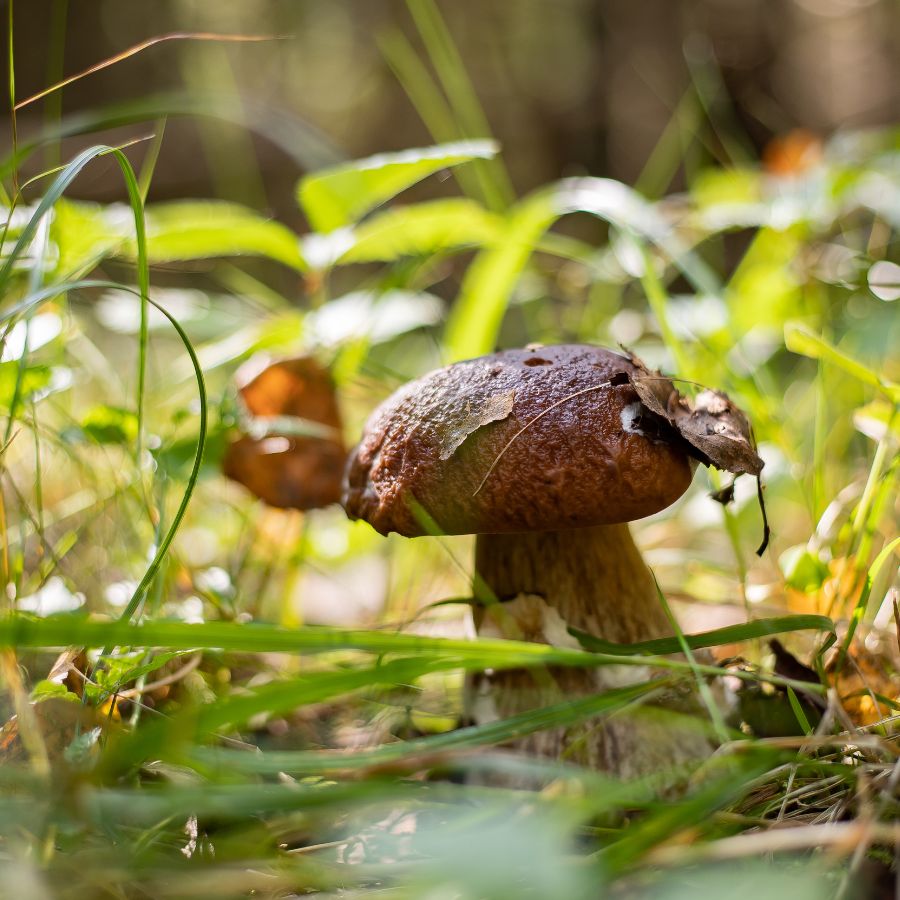
Porcini mushrooms are one of the most sought-after wild edibles in North America. Their meaty texture and rich, nutty flavor make them a favorite among foragers and chefs alike. Knowing when they appear is key if you want to find them in good condition and before the bugs do.
In most western states, porcini season usually runs from late summer into fall. You can start checking in July at higher elevations and continue through September or October depending on the region. In places like the Pacific Northwest and the Rocky Mountains, the timing often lines up with the first good rains after a dry spell.
In the eastern US, porcini mushrooms tend to fruit earlier. They often show up between late spring and mid-summer, especially in hardwood forests with oak or beech. A warm, wet stretch of weather can bring them up quickly, sometimes just days after a heavy rain.
Some parts of the country even have a second flush in the fall. Areas with mixed forests and a long growing season may see porcini pop up again in September or October. Local timing varies a lot, so it helps to learn what to expect in your state and watch the weather closely.
One Final Disclaimer
The information provided in this article is for general informational and educational purposes only. Foraging for wild plants and mushrooms involves inherent risks. Some wild plants and mushrooms are toxic and can be easily mistaken for edible varieties.
Before ingesting anything, it should be identified with 100% certainty as edible by someone qualified and experienced in mushroom and plant identification, such as a professional mycologist or an expert forager. Misidentification can lead to serious illness or death.
All mushrooms and plants have the potential to cause severe adverse reactions in certain individuals, even death. If you are consuming foraged items, it is crucial to cook them thoroughly and properly and only eat a small portion to test for personal tolerance. Some people may have allergies or sensitivities to specific mushrooms and plants, even if they are considered safe for others.
Foraged items should always be fully cooked with proper instructions to ensure they are safe to eat. Many wild mushrooms and plants contain toxins and compounds that can be harmful if ingested.

